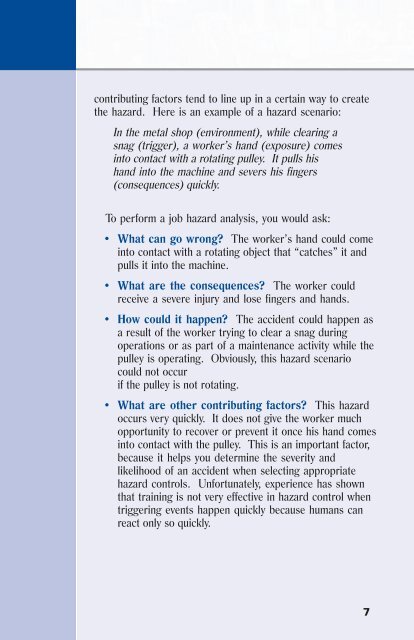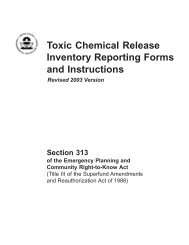OSHA 3071 - Job Hazard Analysis - Seton
OSHA 3071 - Job Hazard Analysis - Seton
OSHA 3071 - Job Hazard Analysis - Seton
Create successful ePaper yourself
Turn your PDF publications into a flip-book with our unique Google optimized e-Paper software.
contributing factors tend to line up in a certain way to create<br />
the hazard. Here is an example of a hazard scenario:<br />
In the metal shop (environment), while clearing a<br />
snag (trigger), a worker’s hand (exposure) comes<br />
into contact with a rotating pulley. It pulls his<br />
hand into the machine and severs his fingers<br />
(consequences) quickly.<br />
To perform a job hazard analysis, you would ask:<br />
• What can go wrong? The worker’s hand could come<br />
into contact with a rotating object that “catches” it and<br />
pulls it into the machine.<br />
• What are the consequences? The worker could<br />
receive a severe injury and lose fingers and hands.<br />
• How could it happen? The accident could happen as<br />
a result of the worker trying to clear a snag during<br />
operations or as part of a maintenance activity while the<br />
pulley is operating. Obviously, this hazard scenario<br />
could not occur<br />
if the pulley is not rotating.<br />
• What are other contributing factors? This hazard<br />
occurs very quickly. It does not give the worker much<br />
opportunity to recover or prevent it once his hand comes<br />
into contact with the pulley. This is an important factor,<br />
because it helps you determine the severity and<br />
likelihood of an accident when selecting appropriate<br />
hazard controls. Unfortunately, experience has shown<br />
that training is not very effective in hazard control when<br />
triggering events happen quickly because humans can<br />
react only so quickly.<br />
7

















